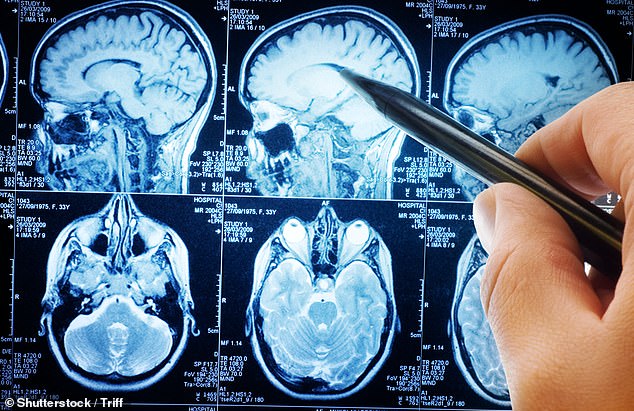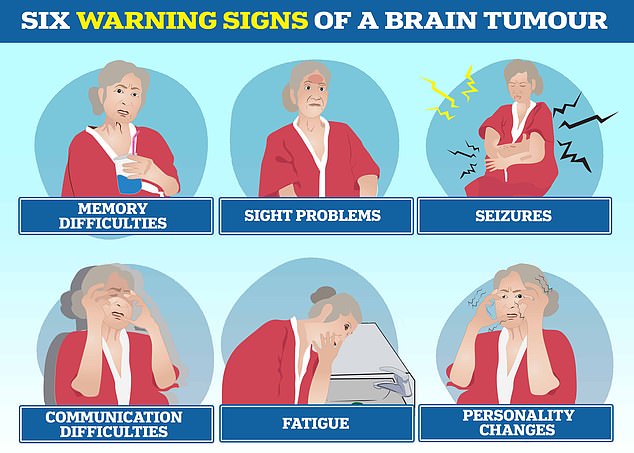Suffering a head injury could raise the risk of developing a brain tumour later in life, concerning research today suggested.
Age, being overweight or obese and exposure to certain types of radiation through x-rays and CT scans, have long been known risk factors of brain tumours.
But, US researchers found adults were ‘significantly’ more likely to develop a malignant brain tumor, a type of cancer that starts in the brain or spreads into the brain from another area of the body, if they had suffered a ‘moderate or a severe traumatic brain injury’.
None of the 150,000 adults tracked by the scientists had any of the three existing risk factors.
Those who had had mild cases of traumatic brain injury, however, such as concussion, had no increased risk of tumours.
Experts today labelled the findings ‘alarming’ and called on medics to monitor those who had suffered traumatic brain injuries for the long term, not just immediately after their injury.
Dr Saef Izzy, a neurologist at Brigham and Women’s Hospital in Boston and study co-author, said: ‘I find these results alarming.
‘Our work over the past five years has shown that a traumatic brain injury is a chronic condition with lasting effects.

Until now, dementia diagnoses often rely on questionnaires to indicate problems with memory as well as MRI scans (pictured) to track loss of brain volume

It is also important to know the tell-tale signs of a brain tumour to help catch in its early stages
‘Now evidence of a potential increased risk of malignant brain tumours adds urgency to shift the focus from short-term recovery to lifelong vigilance.
‘This underscores the importance of long-term monitoring for anyone with a history of a traumatic brain injury.’
In the study, researchers divided 75,000 adults who had suffered a traumatic brain injury into three categories: mild, moderate and severe.
Mild included concussion, while falls and car crashes came under moderate and severe cases.
The other 75,000 study participants had no history of traumatic brain injuries.
They found 87 volunteers in the moderate or severe group developed brain tumours within three to five years of injury—far higher than the mild or control group.
Dr Sandro Marini, a neurologist at Brigham and Women’s Hospital and study co-author, added: ‘While there is an increased risk of tumor from a traumatic brain injury, the overall risk remains low.
‘Still, brain tumor is a devastating disease and often gets detected in later stages.

The Wanted singer Tom Parker (pictured with his wife Kelsey Parker in October 2021) died in March 2022 following an 18-month battle with stage four glioblastoma

The cancer also killed Labour politician Dame Tessa Jowell in 2018
‘Now, we’ve opened the door to monitor traumatic brain injury patients more closely.’
Approximately 5,800 people in the UK and 25,000 in the US are diagnosed with a malignant brain tumour each year.
Adult gliomas, such as glioblastoma, are the most common type of malignant brain tumour.
A glioblastoma is one of the deadliest types of brain tumours.
Typical treatment plans for the ‘aggressive’ cancer sees patients have surgery before chemo and radiotherapy. This is still the same way it was treated in the early 2000s.
Typical symptoms can include headaches, fits, nausea, vomiting, drowsiness, memory difficulties, and personality changes.
Vision or speech problems, progressive weakness or paralysis on one side of the body, as well as behavioural changes, are other key signs.
Average survival time for glioblastoma is between 12 and 18 months, according to the Brain Tumour Charity. Only 5 per cent of patients survive five years, it says.
The disease killed the Labour politician Dame Tessa Jowell in 2018.
In March 2022, The Wanted singer Tom Parker also died following an 18-month battle with stage four glioblastoma.












